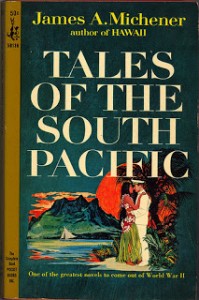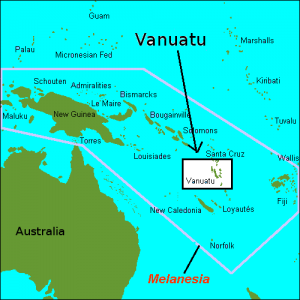 My partner Rose and I will soon be on our way to the island of Espiritu Santo in Vanuatu for a short stay accompanied by a group of Francophiles. One interesting fact about Santo – as it is known by the locals – is that James A. Michener was stationed there during World War Two and the island is the locale depicted, albeit fictitiously, in his Pulitzer Prize (1948) winning novel Tales of the South Pacific, which later became a musical hit on Broadway for many years.
My partner Rose and I will soon be on our way to the island of Espiritu Santo in Vanuatu for a short stay accompanied by a group of Francophiles. One interesting fact about Santo – as it is known by the locals – is that James A. Michener was stationed there during World War Two and the island is the locale depicted, albeit fictitiously, in his Pulitzer Prize (1948) winning novel Tales of the South Pacific, which later became a musical hit on Broadway for many years.
Michener was born in New York City on the third of February 1907. As a teenager, he hitched lifts and rode boxcars across America on a voyage of discovery and learning through his many experiences taking odd-jobs such as working in carnival shows. In later life he also travelled widely for the research of his novels.
In 1929, Michener graduated from Swarthmore College in Pennsylvania with degrees in English and Psychology. He then travelled and studied in Europe for two years before teaching high school English in Pennsylvania. He earned a Master’s degree at the University of Northern Colorado where he then taught for several years. During World War Two he was a naval historian in the South Pacific Ocean and held the rank of Lieutenant. His notes and experiences in the Pacific formed the basis for his first novel Tales of the South Pacific published in 1947. The following is the blurb from the back of the book:
Enter the exotic world of the South Pacific, with its endless ocean, the tiny specks of coral we call islands, the coconut palms, the waves breaking into spray against the reefs, and the full moon rising behind the volcanoes.
Meet the men and women caught up in the drama of a big war. The young Marine who falls madly in love with a beautiful Tonkinese girl. Nurse Nellie and her French planter, Emile De Becque. The soldiers, sailors, and nurses playing at war and waiting for love in a tropic paradise.
Most of Michener’s works are historical novels renowned for the thorough research that is the foundation for his epic stories which sweep through the generations to the background of world history. He has published over four dozen books including: The Source, Hawaii¸ Centennial, Sayonara, Poland, Texas, The Covenant , The Drifters . . .
Santo is the largest of Vanuatu’s 83 islands which are inhabited by the Melanesian Ni Van people. Pottery dated to 1400 BC and brought to the islands by the Lapita has been found on Malo Island off the southern end of Santo. Portuguese explorer Pedro Fernandez de Quires was searching for the southern continent of Terra Australis when he sailed into Big Bay in 1606 and named the land Terra Australis del Espiritu Santo. Captain James Cook was on his second voyage in 1774 when he called the archipelago the New Hebrides, which was changed to Vanuatu on the country gaining its independence in 1980. From 1906, Vanuatu was governed by a French/English Condominium which meant two of everything: laws, including road rules; police forces and prisons; currencies; languages; health and education. During the Blackbirding period from the 1870s until it was outlawed in 1904, thousands of islanders were coerced into labouring on the Queensland sugar cane plantations. Under the threat of Japanese invasion in 1942 the Americans stationed 50,000 men in Luganville on Santo to support three bomber airports and the navy port. Some 500,000 Allied servicemen passed through the islands during the war.


